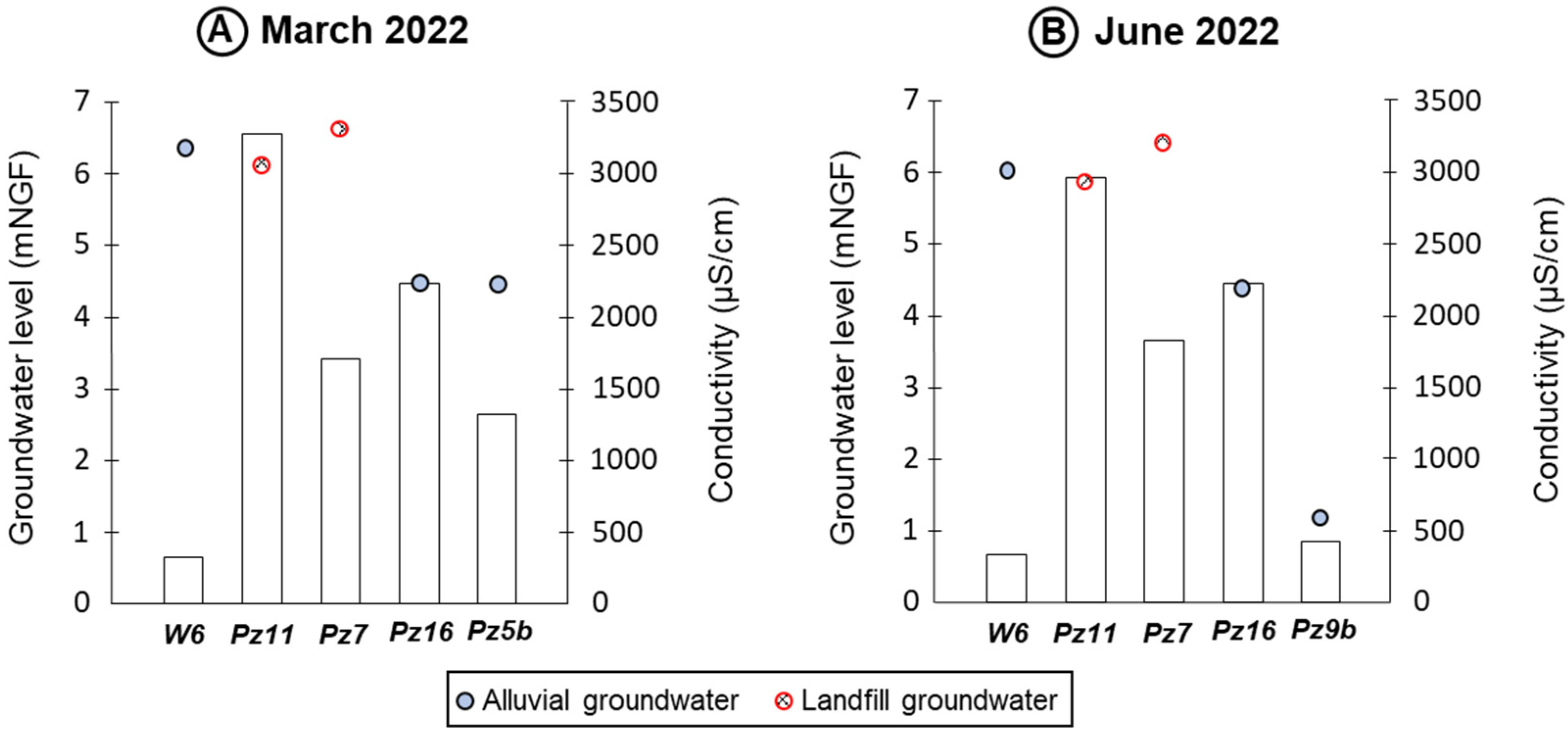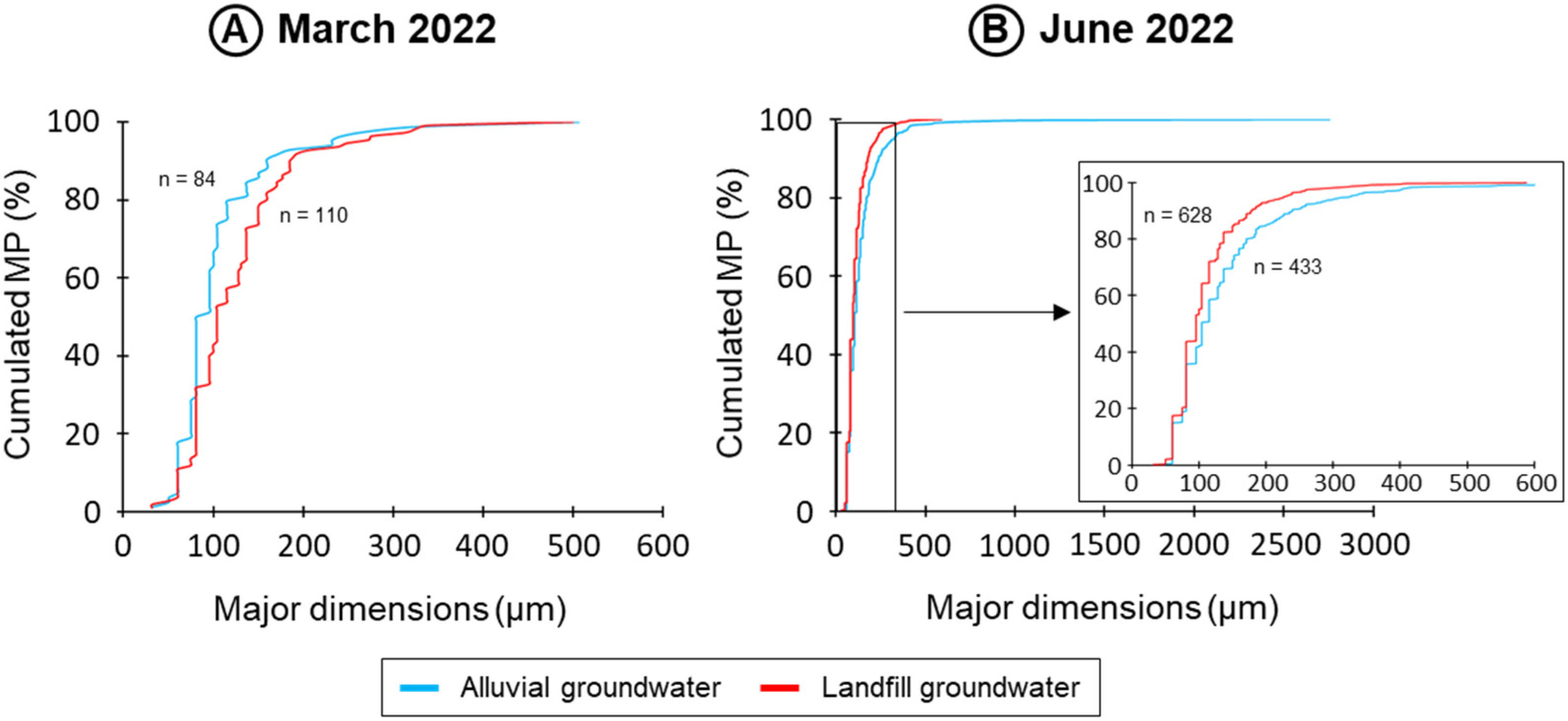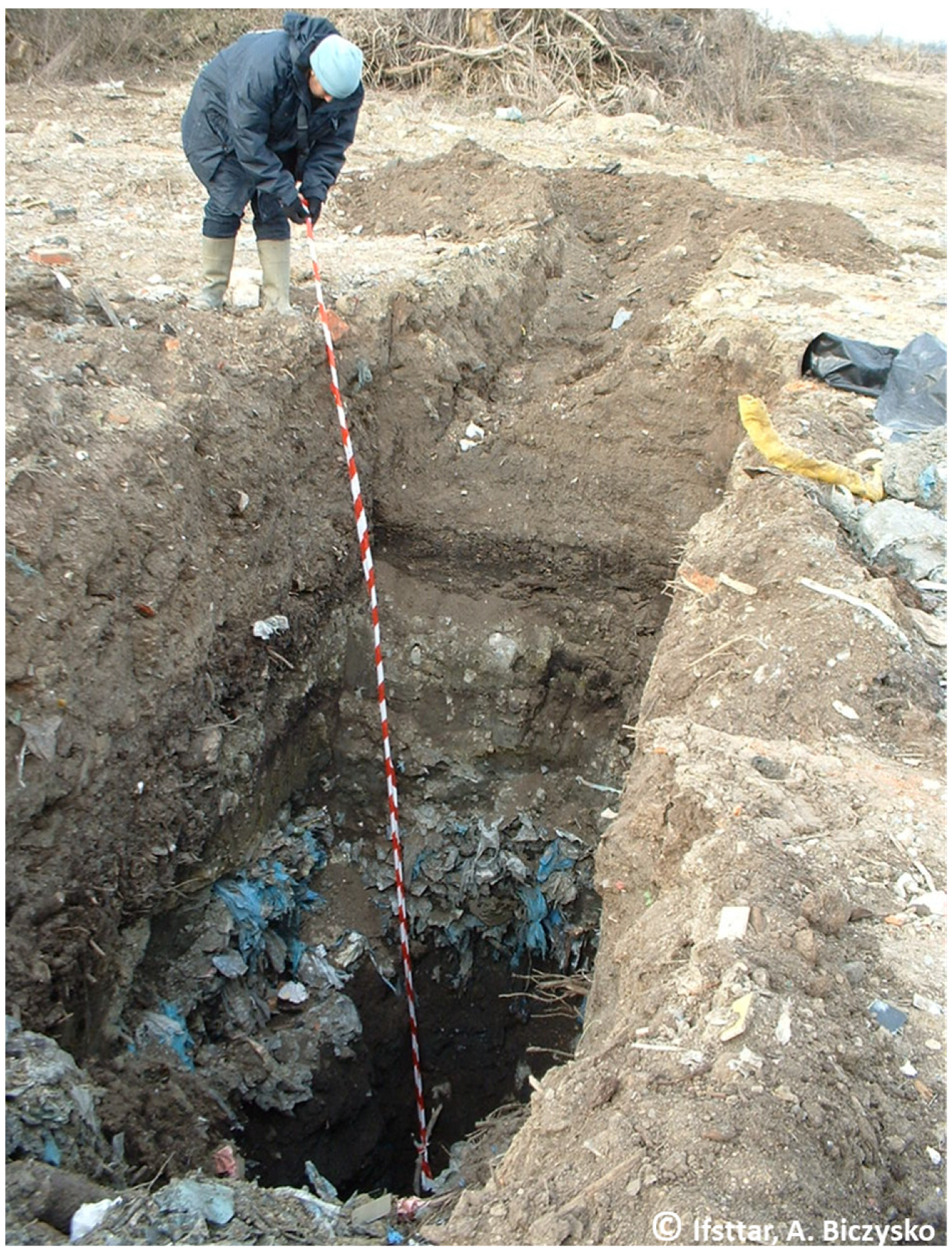May a Former Municipal Landfill Contaminate Groundwater in Microplastics? First Investigations from the “Prairie de Mauves Site” (Nantes, France)
Abstract
:1. Introduction
2. Materials and Methods
2.1. Experimental Site
2.2. Sampling Procedure
2.3. Analytical Method
2.4. Quality Controls
3. Results
3.1. Groundwater Levels and Electric Conductivity
3.2. Microplastic Concentrations
3.3. Microplastic Polymer Types
3.4. Microplastic Size Ranges
4. Discussion
4.1. A Contamination of the Landfill Groundwater Body
4.2. Leakages towards the Alluvial Groundwater Body
4.3. Temporal Variations of Microplastic Concentrations
5. Conclusions
Author Contributions
Funding
Institutional Review Board Statement
Informed Consent Statement
Data Availability Statement
Acknowledgments
Conflicts of Interest
References
- Heinrich Böll Stiftung, La Fabrique Ecologique, Break Free From Plastic. Plastic Atlas—Facts and Figures about the World of Synthetic Polymers 2020. Available online: https://www.boell.de/en/plasticatlas (accessed on 9 January 2022).
- Monkul, M.M.; Özhan, H.O. Microplastic Contamination in Soils: A Review from Geotechnical Engineering View. Polymers 2021, 13, 4129. [Google Scholar] [CrossRef]
- ADEME. Les Déchets En Chiffres; Agence de l’Environnement et de la Maîtrise de l’Energie: Paris, France, 2006; p. 12. [Google Scholar]
- ADEME. Déchets—Chiffres Clés. L’essentiel 2021; Agence de l’Environnement et de la Maîtrise de l’Energie: Angers, France, 2021; p. 36. [Google Scholar]
- Kaza, S.; Yao, L.; Bhada-Tata, P.; Van Woerden, F. What a Waste 2.0: A Global Snapshot of Solid Waste Management to 2050; World Bank Publications: Washington, DC, USA, 2018; p. 295. [Google Scholar]
- Golwala, H.; Zhang, X.; Iskander, S.M.; Smith, A.L. Solid Waste: An Overlooked Source of Microplastics to the Environment. Sci. Total Environ. 2021, 769, 144581. [Google Scholar] [CrossRef]
- Wan, Y.; Chen, X.; Liu, Q.; Hu, H.; Wu, C.; Xue, Q. Informal Landfill Contributes to the Pollution of Microplastics in the Surrounding Environment. Environ. Pollut. 2022, 293, 118586. [Google Scholar] [CrossRef]
- OPECST. Les Nouvelles Techniques de Recyclage et de Valorisation des Déchets Ménagers et des Déchets Industriels Banals; Office Parlementaire D’évaluation des Choix Scientifiques et Technologiques: Paris, France, 1999. [Google Scholar]
- OPECST. Le Guide de L’ademe sur L’incidence des Décharges sur la Qualité de L’eau; Office Parlementaire D’évaluation des Choix Scientifiques et Technologiques: Paris, France, 2002. [Google Scholar]
- WWF. Stoppons le Torrent de Plastique ! Guide à Destination des Décideurs Français Pour Sauver la Méditerranée; WWF Mediterranean Marine Initiative: Rome, Italy, 2019; p. 19. [Google Scholar]
- Mallavan, A.-M.; Mimoun, N.; Rotman, G. La croissance des déchets ménagers. Econ. Stat. 1986, 185, 57–64. [Google Scholar] [CrossRef]
- OPECST. Pollution Plastique: Une Bombe À Retardement? Office Parlementaire D’évaluation des Choix Scientifiques et Technologiques: Paris, France, 2020; p. 15. [Google Scholar]
- Silva, A.L.P.; Prata, J.C.; Duarte, A.C.; Soares, A.M.V.M.; Barceló, D.; Rocha-Santos, T. Microplastics in Landfill Leachates: The Need for Reconnaissance Studies and Remediation Technologies. Case Stud. Chem. Environ. Eng. 2021, 3, 100072. [Google Scholar] [CrossRef]
- Upadhyay, K.; Bajpai, S. Microplastics in Landfills: A Comprehensive Review on Occurrence, Characteristics and Pathways to the Aquatic Environment. Nat. Environ. Pollut. Technol. 2021, 20, 1935–1945. [Google Scholar] [CrossRef]
- Al-Yaqout, A.; Hamoda, M.F. Long-Term Temporal Variations in Characteristics of Leachates from a Closed Landfill in an Arid Region. Water Air Soil Pollut. 2020, 231, 319. [Google Scholar] [CrossRef]
- Wagner, M.; Lambert, S. Freshwater Microplastics: Emerging Environmental Contaminants? In The Handbook of Environmental Chemistry; Springer International Publishing: Cham, Switzerland, 2018; Volume 58, ISBN 978-3-319-61614-8. [Google Scholar]
- He, P.; Chen, L.; Shao, L.; Zhang, H.; Lü, F. Municipal Solid Waste (MSW) Landfill: A Source of Microplastics? Evidence of Microplastics in Landfill Leachate. Water Res. 2019, 159, 38–45. [Google Scholar] [CrossRef]
- Kabir, M.S.; Wang, H.; Luster-Teasley, S.; Zhang, L.; Zhao, R. Sources, Occurrence, and Removal of Microplastic/Nanoplastic in Landfill Leachate: A Comprehensive Review. Intend. Water Res. 2022. [Google Scholar] [CrossRef]
- Kilponen, J. Microplastics and Harmful Substances in Urban Runoffs and Landfill Leachates—Possible Emission Sources to Marine Environment; Lahti University of Applied Sciences: Lahti, Finland, 2016. [Google Scholar]
- Mohammadi, A.; Malakootian, M.; Dobaradaran, S.; Hashemi, M.; Jaafarzadeh, N. Occurrence, Seasonal Distribution, and Ecological Risk Assessment of Microplastics and Phthalate Esters in Leachates of a Landfill Site Located near the Marine Environment: Bushehr Port, Iran as a Case. Sci. Total Environ. 2022, 842, 156838. [Google Scholar] [CrossRef] [PubMed]
- Su, Y.; Zhang, Z.; Wu, D.; Zhan, L.; Shi, H.; Xie, B. Occurrence of Microplastics in Landfill Systems and Their Fate with Landfill Age. Water Res. 2019, 164, 114968. [Google Scholar] [CrossRef] [PubMed]
- van Praagh, M.; Hartman, C.; Brandmyr, E. Microplastics in Landfill Leachates in the Nordic Countries; Nordic Council of Ministers: Copenhagen, Denmark, 2019; ISBN 978-92-893-5914-6. [Google Scholar]
- Yu, F.; Wu, Z.; Wang, J.; Li, Y.; Chu, R.; Pei, Y.; Ma, J. Effect of Landfill Age on the Physical and Chemical Characteristics of Waste Plastics/Microplastics in a Waste Landfill Sites. Environ. Pollut. 2022, 306, 119366. [Google Scholar] [CrossRef] [PubMed]
- Bordoloi, S.; Gupt, C.B.; Sarmah, A.K. Exploring the Theoretical Effects of Landfill Based Microplastic Accumulation on the Hydro-Mechanical Properties of Porous Soil Media. Curr. Opin. Environ. Sci. Health 2022, 26, 100332. [Google Scholar] [CrossRef]
- Viaroli, S.; Lancia, M.; Re, V. Microplastics Contamination of Groundwater: Current Evidence and Future Perspectives. A Review. Sci. Total Environ. 2022, 824, 153851. [Google Scholar] [CrossRef]
- Alemayehu, T.; Mebrahtu, G.; Hadera, A.; Bekele, D.N. Assessment of the Impact of Landfill Leachate on Groundwater and Surrounding Surface Water: A Case Study of Mekelle City, Northern Ethiopia. Sustain. Water Resour. Manag. 2019, 5, 1641–1649. [Google Scholar] [CrossRef]
- Lotram, Y. Méthodologie D’étude Multi-Échelle Du Transport de Polluants Dans les Sols Urbains—Application à Une Ancienne Décharge de Déchets Municipaux sur Nantes; Ecole Centrale de Nantes: Nantes, France, 2012. [Google Scholar]
- Le Guern, C.; Bechet, B.; Minet, L.; Lepinay, A. Transfert de substances émergentes dans les eaux souterraines depuis une ancienne décharge (Nantes, France). In Proceedings of the SHF: ”Les Polluants Émergents: De Nouveaux défis Pour la Gestion des Eaux Souterraines?”, Orléans, France, 19–20 May 2016. [Google Scholar]
- Lotram, Y.; Le Guern, C.; Béchet, B.; Lassabatère, L.; Andrieu, H. Transfert de polluants depuis une ancienne décharge urbaine: Apports de la caractérisation physico-chimique des déchets. Tech. Sci. Méthodes 2011, 10, 62–71. [Google Scholar] [CrossRef]
- Treilles, R.; Gasperi, J.; Tramoy, R.; Dris, R.; Gallard, A.; Partibane, C.; Tassin, B. Microplastic and Microfiber Fluxes in the Seine River: Flood Events versus Dry Periods. Sci. Total Environ. 2022, 805, 150123. [Google Scholar] [CrossRef]
- Nakajima, R.; Tsuchiya, M.; Lindsay, D.J.; Kitahashi, T.; Fujikura, K.; Fukushima, T. A New Small Device Made of Glass for Separating Microplastics from Marine and Freshwater Sediments. PeerJ 2019, 12, e7915. [Google Scholar] [CrossRef]
- Primpke, S.; Wirth, M.; Lorenz, C.; Gerdts, G. Reference Database Design for the Automated Analysis of Microplastic Samples Based on Fourier Transform Infrared (FTIR) Spectroscopy. Anal. Bioanal. Chem. 2018, 410, 5131–5141. [Google Scholar] [CrossRef]
- Kazour, M.; Terki, S.; Rabhi, K.; Jemaa, S.; Khalaf, G.; Amara, R. Sources of Microplastics Pollution in the Marine Environment: Importance of Wastewater Treatment Plant and Coastal Landfill. Mar. Pollut. Bull. 2019, 146, 608–618. [Google Scholar] [CrossRef]
- Nurhasanah; Cordova, M.R.; Riani, E. Micro- and Mesoplastics Release from the Indonesian Municipal Solid Waste Landfill Leachate to the Aquatic Environment: Case Study in Galuga Landfill Area, Indonesia. Mar. Pollut. Bull. 2021, 163, 111986. [Google Scholar] [CrossRef] [PubMed]
- Sun, J.; Zhu, Z.-R.; Li, W.-H.; Yan, X.; Wang, L.-K.; Zhang, L.; Jin, J.; Dai, X.; Ni, B.-J. Revisiting Microplastics in Landfill Leachate: Unnoticed Tiny Microplastics and Their Fate in Treatment Works. Water Res. 2021, 190, 116784. [Google Scholar] [CrossRef]
- Bharath K, M.; Natesan, U.; Vaikunth, R.; Kumar, P.; Ruthra, R.; Srinivasalu, S. Spatial Distribution of Microplastic Concentration around Landfill Sites and Its Potential Risk on Groundwater. Chemosphere 2021, 277, 130263. [Google Scholar] [CrossRef]
- Samandra, S.; Johnston, J.M.; Jaeger, J.E.; Symons, B.; Xie, S.; Currell, M.; Ellis, A.V.; Clarke, B.O. Microplastic Contamination of an Unconfined Groundwater Aquifer in Victoria, Australia. Sci. Total Environ. 2022, 802, 149727. [Google Scholar] [CrossRef]
- Barbier, J.-S.; Dris, R.; Lecarpentier, C.; Raymond, V.; Delabre, K.; Thibert, S.; Tassin, B.; Gasperi, J. Microplastic Occurrence after Conventional and Nanofiltration Processes at Drinking Water Treatment Plants: Preliminary Results. Front. Water 2022, 4, 886703. [Google Scholar] [CrossRef]
- Geyer, R.; Jambeck, J.R.; Law, K.L. Production, Use, and Fate of All Plastics Ever Made. Sci. Adv. 2017, 3, e1700782. [Google Scholar] [CrossRef]
- Le Guern, C. Séparation de Déchets de Plastiques par Voie Physico-Chimique (Flottation-Moussage) en Vue de Leur Recyclage—Application au Mélange PVC/PET Bouteilles; Institut National Polytechnique de Lorraine: Vandoeuvre-lès-Nancy, France, 1997. [Google Scholar]
- Chamas, A.; Moon, H.; Zheng, J.; Qiu, Y.; Tabassum, T.; Jang, J.H.; Abu-Omar, M.; Scott, S.L.; Suh, S. Degradation Rates of Plastics in the Environment. ACS Sustain. Chem. Eng. 2020, 8, 3494–3511. [Google Scholar] [CrossRef]
- PlasticsEurope. Plastics—The Facts 2020, an Analysis of European Plastics Production, Demand and Waste Data; Association of Plastics Manufacturer: Brussels, Belgium, 2020; p. 61. [Google Scholar]
- Canopoli, L.; Coulon, F.; Wagland, S.T. Degradation of Excavated Polyethylene and Polypropylene Waste from Landfill. Sci. Total Environ. 2020, 698, 134125. [Google Scholar] [CrossRef]
- He, B.; Smith, M.; Egodawatta, P.; Ayoko, G.A.; Rintoul, L.; Goonetilleke, A. Dispersal and Transport of Microplastics in River Sediments. Environ. Pollut. 2021, 279, 116884. [Google Scholar] [CrossRef]
- de Carvalho, A.R.; Garcia, F.; Riem-Galliano, L.; Tudesque, L.; Albignac, M.; ter Halle, A.; Cucherousset, J. Urbanization and Hydrological Conditions Drive the Spatial and Temporal Variability of Microplastic Pollution in the Garonne River. Sci. Total Environ. 2021, 769, 144479. [Google Scholar] [CrossRef] [PubMed]
- Belkhiri, A.H.; Carre, F.; Quiot, F. State of Knowledge and Future Research Needs on Microplastics in Groundwater. J. Water Health 2022, 20, 1479–1496. [Google Scholar] [CrossRef] [PubMed]
- Gao, J.; Pan, S.; Li, P.; Wang, L.; Hou, R.; Wu, W.-M.; Luo, J.; Hou, D. Vertical Migration of Microplastics in Porous Media: Multiple Controlling Factors under Wet-Dry Cycling. J. Hazard. Mater. 2021, 419, 126413. [Google Scholar] [CrossRef] [PubMed]
- Severini, E.; Ducci, L.; Sutti, A.; Robottom, S.; Sutti, S.; Celico, F. River–Groundwater Interaction and Recharge Effects on Microplastics Contamination of Groundwater in Confined Alluvial Aquifers. Water 2022, 14, 1913. [Google Scholar] [CrossRef]
- O’Connor, D.; Pan, S.; Shen, Z.; Song, Y.; Jin, Y.; Wu, W.-M.; Hou, D. Microplastics Undergo Accelerated Vertical Migration in Sand Soil Due to Small Size and Wet-Dry Cycles. Environ. Pollut. 2019, 249, 527–534. [Google Scholar] [CrossRef]
- Goeppert, N.; Goldscheider, N. Experimental Field Evidence for Transport of Microplastic Tracers over Large Distances in an Alluvial Aquifer. J. Hazard. Mater. 2021, 408, 124844. [Google Scholar] [CrossRef]
- Zhang, X.; Chen, Y.; Li, X.; Zhang, Y.; Gao, W.; Jiang, J.; Mo, A.; He, D. Size/Shape-Dependent Migration of Microplastics in Agricultural Soil under Simulative and Natural Rainfall. Sci. Total Environ. 2022, 815, 152507. [Google Scholar] [CrossRef]
- An, X.; Li, W.; Lan, J.; Adnan, M. Preliminary Study on the Distribution, Source, and Ecological Risk of Typical Microplastics in Karst Groundwater in Guizhou Province, China. Int. J. Environ. Res. Public. Health 2022, 19, 14751. [Google Scholar] [CrossRef]
- Park, S.; Kim, I.; Jeon, W.H.; Moon, H.S. Exploring the Vertical Transport of Microplastics in Subsurface Environments: Lab-Scale Experiments and Field Evidence for Their Presence. SSRN Electron. J. 2022, 4265532. [Google Scholar] [CrossRef]







| Country | Locality/Name | Active/Closed Landfill | Compartment | Concentration (MP/L) | Predominant Size Range (µm) | Analyzed Size Cut-off (µm) | Analytical Method | References |
|---|---|---|---|---|---|---|---|---|
| China | Shanghai | Closed | Leachates | 0.96–1.38 | 100–1000 | 25 | FTIR, µFTIR | [17] |
| Active | 0.79–18.38 | |||||||
| Wuxi/Suzhou/ Changzhou | 0.42–3.58 | |||||||
| Iran | Bushehr | 63.00–92.00 | 1000–5000 | 25 | Microscope, µRaman | [20] | ||
| Indonesia | Galuga | 0.06 | 300–500 | <80 | Microscope, FTIR and µFTIR | [34] | ||
| Finland | Korvenmäki | Active | 1.10 | 50–500 | 50 | ATR-FTIR | [22] | |
| Topinoja | Closed | 0.16 | ||||||
| Kujala | 0.00 | |||||||
| Norway | Anonymous 2 | 1.40 | ||||||
| Gjerdrum | Active | 1.00 | ||||||
| Iceland | Fiflhotl old cell | Closed | 0.00 | |||||
| Alfsnes | Active | 4.51 | ||||||
| China | Laogang | 4.00–13.00 | 500–1000 | <70 | ATR-µFTIR | [21] | ||
| Suzhou | 218.30–252.50 | 10–50 | 10 | µRaman | [35] | |||
| China | Shenzhen Shantou | 3.00–25.00 | 30–150 | 30 | Microscope, micrograph, Raman and µFTIR | [7] | ||
| Groundwater (near a landfill) | 11.00–17.00 | |||||||
| India | Perugundi | 7.00–80.00 | 10–500 | 10 | ATR-FTIR | [36] | ||
| India | Kodungaiyur | 3.00–23.00 | ||||||
| Australia | Bacchus Marsh | / | Groundwater | 16.00–97.00 | 18–491 | 20 | LDIR | [37] |
| France | Seine, Marne and Oise Rivers | / | Surface waters | 7.80–45.00 | 128 * | 25 | ATR-FTIR | [38] |
Disclaimer/Publisher’s Note: The statements, opinions and data contained in all publications are solely those of the individual author(s) and contributor(s) and not of MDPI and/or the editor(s). MDPI and/or the editor(s) disclaim responsibility for any injury to people or property resulting from any ideas, methods, instructions or products referred to in the content. |
© 2023 by the authors. Licensee MDPI, Basel, Switzerland. This article is an open access article distributed under the terms and conditions of the Creative Commons Attribution (CC BY) license (https://creativecommons.org/licenses/by/4.0/).
Share and Cite
Ledieu, L.; Phuong, N.-N.; Flahaut, B.; Radigois, P.; Papin, J.; Le Guern, C.; Béchet, B.; Gasperi, J. May a Former Municipal Landfill Contaminate Groundwater in Microplastics? First Investigations from the “Prairie de Mauves Site” (Nantes, France). Microplastics 2023, 2, 93-106. https://doi.org/10.3390/microplastics2010007
Ledieu L, Phuong N-N, Flahaut B, Radigois P, Papin J, Le Guern C, Béchet B, Gasperi J. May a Former Municipal Landfill Contaminate Groundwater in Microplastics? First Investigations from the “Prairie de Mauves Site” (Nantes, France). Microplastics. 2023; 2(1):93-106. https://doi.org/10.3390/microplastics2010007
Chicago/Turabian StyleLedieu, Lauriane, Ngoc-Nam Phuong, Bernard Flahaut, Pauline Radigois, Julya Papin, Cécile Le Guern, Batrice Béchet, and Johnny Gasperi. 2023. "May a Former Municipal Landfill Contaminate Groundwater in Microplastics? First Investigations from the “Prairie de Mauves Site” (Nantes, France)" Microplastics 2, no. 1: 93-106. https://doi.org/10.3390/microplastics2010007
APA StyleLedieu, L., Phuong, N.-N., Flahaut, B., Radigois, P., Papin, J., Le Guern, C., Béchet, B., & Gasperi, J. (2023). May a Former Municipal Landfill Contaminate Groundwater in Microplastics? First Investigations from the “Prairie de Mauves Site” (Nantes, France). Microplastics, 2(1), 93-106. https://doi.org/10.3390/microplastics2010007






